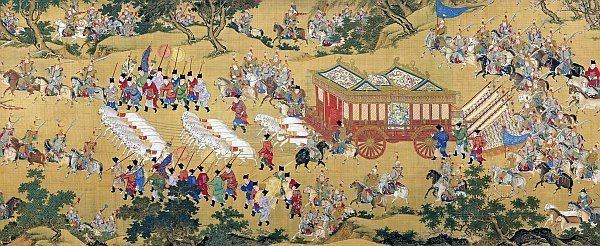Chinese 三皇五帝 Wade–Giles San Huang Wu Ti | Hanyu Pinyin | |
 | ||
The Three Sovereigns and Five Emperors were a group of mythological rulers or deities in ancient northern China who in later history have been assigned dates in a period from circa 2852 BC to 2070 BC. Today they are considered culture heroes.
Contents
The dates of these mythological figures may be fictitious, but according to some accounts and reconstructions, they preceded the Xia Dynasty (which itself is prehistoric, without writing, and which is likewise also documented only in much later written sources).
Description
The Three Sovereigns, sometimes known as the Three August Ones, were said to be god-kings or demigods who used their abilities to improve the lives of their people and impart to them essential skills and knowledge. The Five Emperors are portrayed as exemplary sages who possessed great moral character and lived to a great age and ruled over a period of great peace. The Three Sovereigns are ascribed various identities in different Chinese historical texts.
These kings are said to have helped introduce the use of fire, taught people how to build houses and invented farming. The Yellow Emperor's wife is credited with the invention of silk culture. The discovery of medicine, the invention of the calendar and Chinese script are also credited to the kings. After their era, Yu the Great founded the Xia Dynasty.
According to a modern theory with roots in the late 19th century, the Yellow Emperor is supposedly the ancestor of the Huaxia people. The Mausoleum of the Yellow Emperor was established in Shaanxi Province to commemorate the ancestry legend.
The Chinese character for emperor, huangdi (皇帝), derives from this, as the first user of this title Qin Shi Huang considered his reunion of all of the lands of the former Kingdom of Zhou to be greater than even the Three Sovereigns and Five Emperors.
The Four/Five shi
A related concept appears in the legend of the Four shi (四氏) who took part in creating the world. The four members are Youchao-shi (有巢氏), Suiren-shi (燧人氏), Fuxi-shi (伏羲氏), and Shennong-shi (神農氏). The list sometimes extends to one more member being Nüwa-shi (女媧氏), making Five shi (五氏). Four of these five names appear in different lists of the Three Sovereigns.
Variations
Depending on the source, there are many variations of who classifies as the Three Sovereigns or the Five Emperors. There are at least six to seven known variations. Many of the sources listed below were written in much later periods, centuries and even millennia after the supposed existence of these figures, and instead of historical fact, they may reflect a desire in later time periods to create a fictitious ancestry traceable to ancient culture heroes. The Emperors were asserted as ancestors of the Xia, Shang, and Zhou dynasties. The following appear in different groupings of the Three Sovereigns: Fuxi (伏羲), Nüwa (女媧), Shennong (神農), Suiren (燧人), Zhurong (祝融), Gong Gong (共工), Heavenly Sovereign (天皇), Earthly Sovereign (地皇), Tai Sovereign (泰皇), Human Sovereign (人皇), and even the Yellow Emperor (黄帝).
The following appear in different groupings of the Five Emperors: Yellow Emperor (黃帝), Zhuanxu (顓頊), Emperor Ku (嚳), Emperor Yao (堯), Emperor Shun (舜), Shaohao (少昊), Taihao (太昊), and Yan Emperor (炎帝).
